Yidinji - People of the Rainforest
Note: contains images and the name of the now deceased elder - images are
used with his permission
Yidinji - People of the Rainforest
Yidinji Lands and Seasons
Step by step - How to restore an ancient stone axehead to functional condition using traditional methods and materials
Geoarchaeology - A multi-dimensional
approach to functional analysis or how we used rock type, edge angles
and scratch marks to figure out the uses and origins of each of the
stone tools
Terrain analysis - tracing the 1000km trade route of axe #4 from Mt. Isa to Herberton
Environmental Reasoning on the Exposure of the Axeheads
Each tool tells its story + the wisdom of the elder where our scientific analysis was wrong and corrected by first hand knowledge
An "axehead" is a general name for a large stone tool
Axeheads were an essential economic resource to the Aboriginal people of 150 years ago, just as copper or iron or gold are today.
Axeheads are highly specialised and require a sophisticated knowledge of geology, physics and chemistry in their production as this website will show.
The higher the level of craftsmanship / specialisation, the more useful and more highly regarded they are. Axeheads also provide an opportunity for trade and interaction with other groups of people.
The Rainforest People create some exceptionally large stone tools and some unique "T-shaped" stone tools part of a huge array of stone and wooden tools.
The Yidinji Lands and Seasons

The Yidinji are an Aboriginal tribe whose traditional lands extend from the Cairns area along the coastal plain to around the mouth of the Mulgrave River and areas of the Atherton Tableland. The Mullunburra - people of the stony river bed - (‘Mullun’ meaning stony river and creek bed and ‘burra’ meaning to belong to) are a clan of the Yidinji Tribe. Each year they traveled back and forth along a traditional route between camps in the Goldsborough Valley and the bora grounds (warrama) behind Lake Eacham on Fullers Road. The camps were connected by tributaries of the river that gave its name to the Mullunburra. The Mullunburra-Yidinji enjoyed a lifestyle based on hunting, gathering and fishing. Uniquely suited to their environment, their lives were governed by the seasonal changes and the consequent effect on the availability of food. Distinctive aspects of rainforest culture included the holding of intertribal fighting corroborees using huge swords and shields, the regular use, after complex processing, of poisonous plants as a food source and horned shaped lawyer cane baskets made only in the Cairns to Cardwell region. Tribal movement and ceremonial activities were of necessity keyed into the seasonal cycle, the unity between the people and the land provided the basis for all aspects of life. The Mullunburra were very sensitive and alert to the flowering and fruiting of trees, the nesting of birds and the habits of animals. They knew what they fed on, where they rested, the paths they used. The arrival of gunyal (the cicada) in the clan’s traditional area heralds the start of the wet season, and the availability of the food sources of blackpine, yellow walnut and eggs of the scrub turkey. When gunyal changes his tune in song this told the aborigines the food was ready to eat, and their trek up to the Tablelands followed. The appearance of animals, the flowering of plants, many of the forests natural cycles, told the people what foods were ready to gather. The judaloo (Brown pigeon) calling told the women that the jumbun grub was ready to eat; the falling fruit of garangal vine meant the scrub turkey eggs were available.
The Migration Food Cycle - The Yidinji Seasons
NYANBIRR...WET SEASON January through May Head up the valley - Scrub turkey's nest for eggs White-tailed rat camps in hollow logs; easy to find and kill Flying fox - hit with a stick. Men hunt for tree kangaroo, possum, wallaby, cassowary and birds. Women and children collect yellow and black walnut and black pine. Excess is wrapped in ginger leaves and placed in a cool stream
YIWAI...WINTER June and July Start back to the coast - Scrub python eaten mainly in Winter; grubs and brown and black frogs - part of winter diet - Eat yams and cycads. When the cicada's call changes the blackpine and walnut are ready to eat. When the wattle starts flowering go down the trail to the coast. The Python is then out from hibernation and ready to eat.
NAMBARR...SPRING August, September, October Start back to the coast - Echidna, turtles, eels and fish were easier to catch as the water dropped. Davidsonian Plum from July through to September
TJUKALAWARR...SUMMER November and December Goanna and Snakes were hunted either side of winter. Eat white apple straight off the tree; gather Badil (Cycad); collect yellow and black walnut in lowlands.
Yidinji Elder Nungbana (George Davis) shows...
Step by step - How to restore a stone axehead to functional condition using traditional materials
Click on any image for a larger versionGirls were given permission by Nungbana to watch and participate in this process.
Images 01-02
Splitting Lawyer Cane (Calamus spp. ) to make the handle and wrapping for the stone axe.
The short,thick length of Lawyer Cane for the handle is slightly green and will shrink slightly when dry.
The thin, long wrapping is mature but greener and will shrink considerably as it gets drier.
The shrinkage will tighten the grip of the handle on the stone axe.
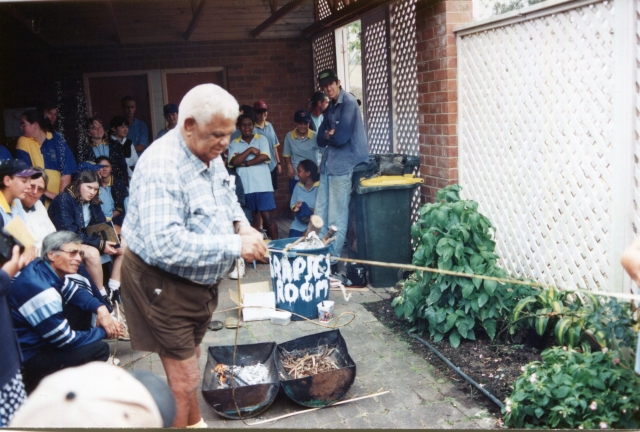
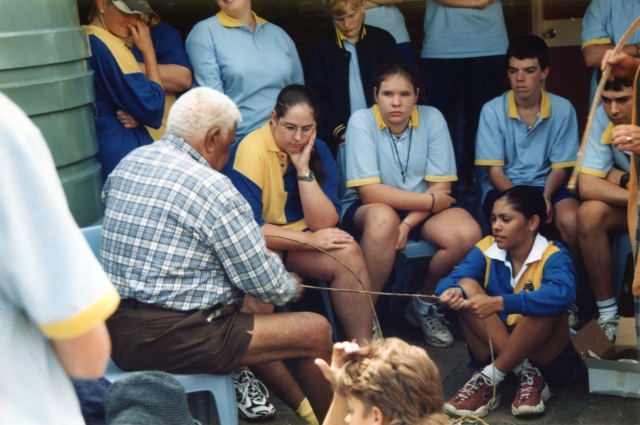
Image 03
Warming split cane to make it pliable

Images 04-05
Smoothing interior surface of cane handle to maximise contact area with stone axehead

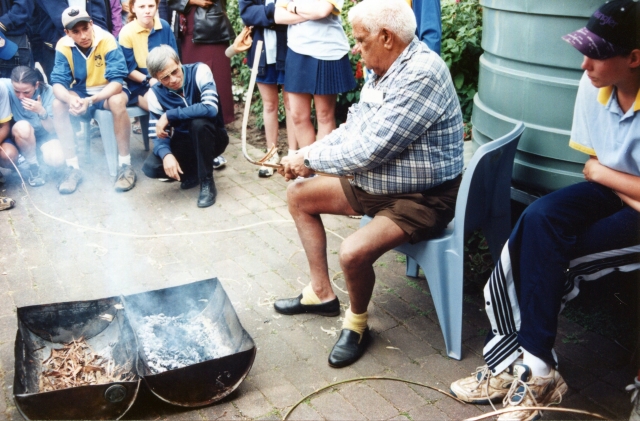
Image 06
Resin (dried sap) from the Grass Tree ( Xanthorrhoea spp. ) used as part of a two part glue
The Grass Tree is found in drier open, often sloping country that experiences periodic fires.
Although not specifically a plant for fibre it was very useful in crafting of aboriginal tools. The light straight flower stalk served as a butt-piece for spears.
A tip section of tea tree would then be attached to the end of the spear and hardened in the fire before used for hunting. fire with a drilling stick.
The leaves produce a hard waterproof resin, which could be collected from the base of the trunk.
This resin melts when warmed, but sets hard when cold. It had a number of uses including;
- Forming glue by mixing it with charcoal, beeswax or fine sand and dust.
- Gluing the cement stone heads to wooden handles and spears to shafts and tips.
- Waterproofing bark canoes and water carrying vessels.
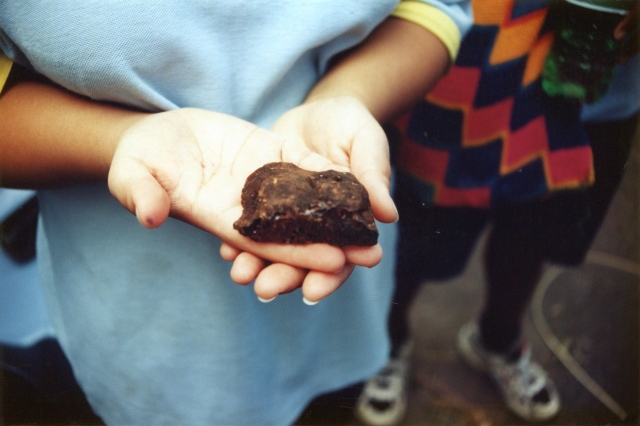
Images 07-08
Making the two part glue
Part 1 - Grass Tree resin is powdered and and mixed into a thick paste with warm water
Part 2 - buried charcoal (activated carbon) from a root fire of the Kauri Pine is powdered and added to the resin
The Kauri Pine (Agathis spp.) is an emergent rainforest tree, found on level ground with deep soil and is liable to be struck by lightning.
Presumably, the activated carbon draws metallic ions from the resin causing it to thicken and solidify.
The rate of this reaction is increased by pre-heating the stone axes.( see Image 09...)
Once dry, the glue will not remelt.
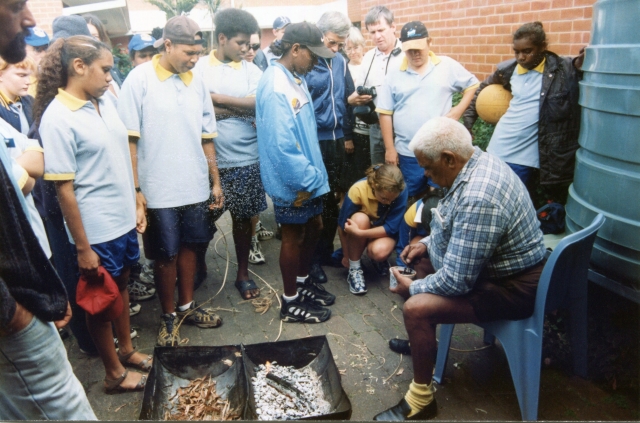
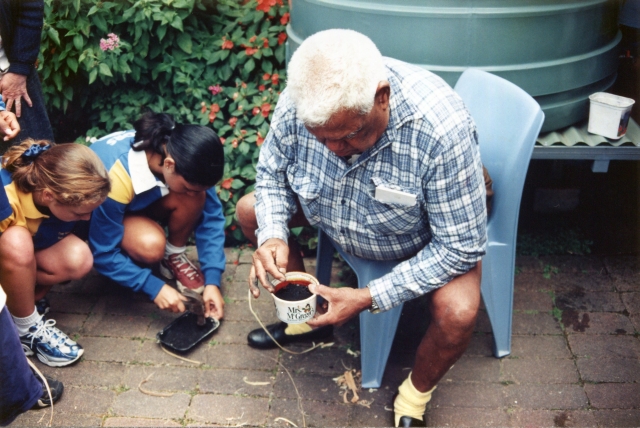
Image 09
Stone axeheads are pre-heated before the addition of the glue.
The hot stone assists in getting the glue to flow into all crevices and keeps the cane pliable while it is fitted to the axe.
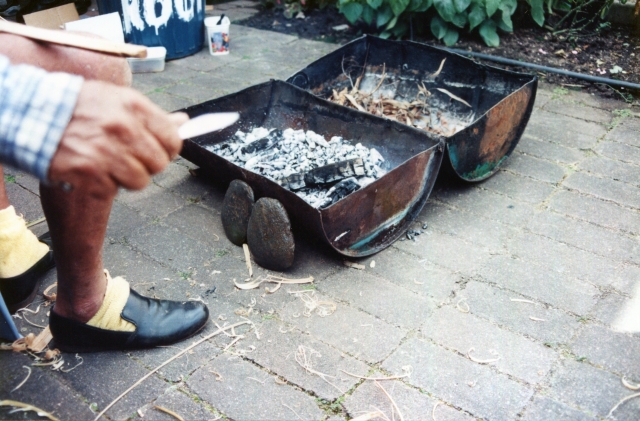
Images 10-11-12
Spreading the glue on the inside of the axe handle.
Note the two part contact glue is spread on both the stone axe and the handle surfaces.
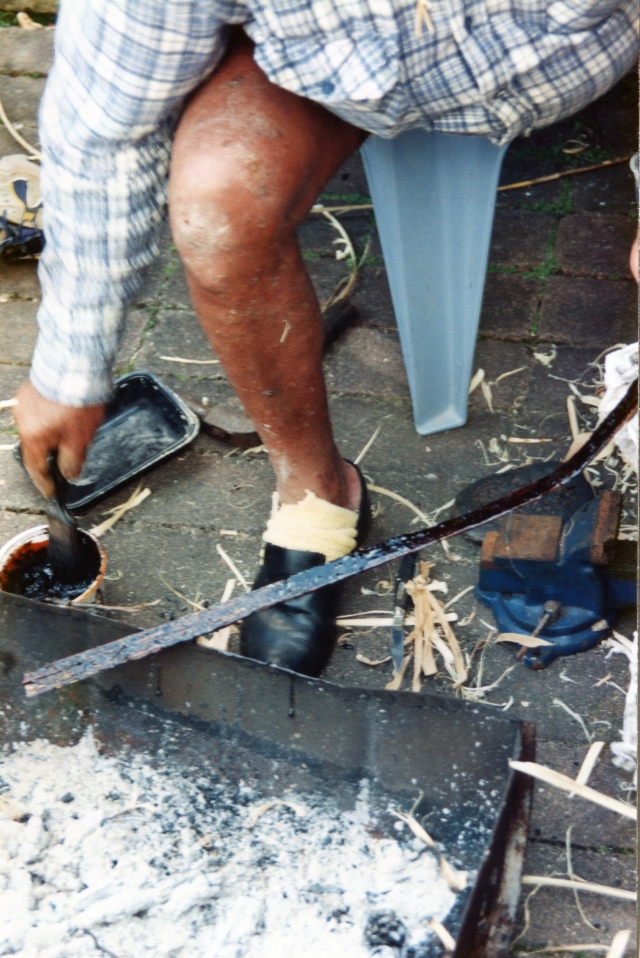
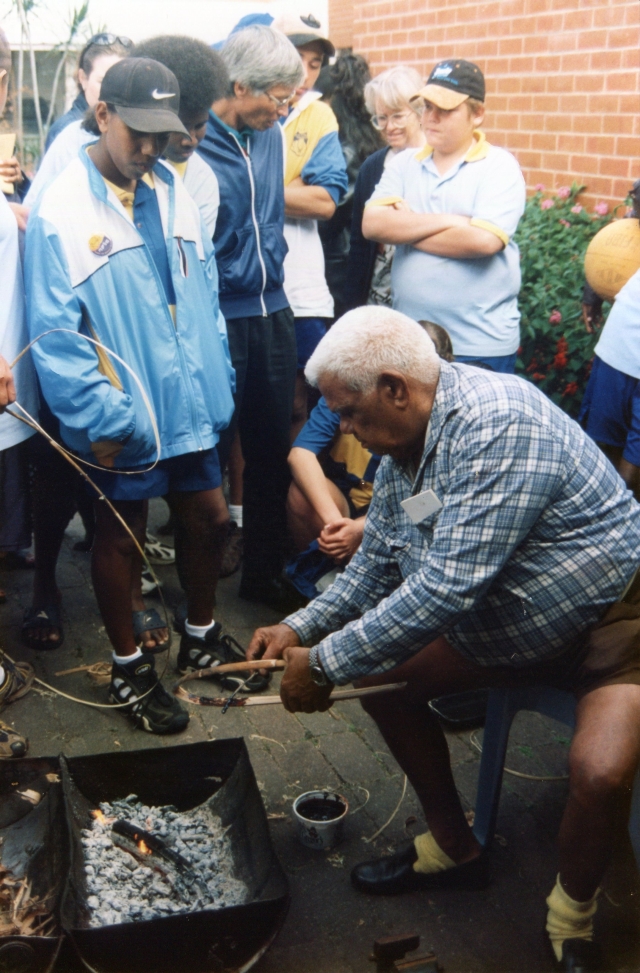

Image 13
Glue on axehead is left to cool until very sticky.
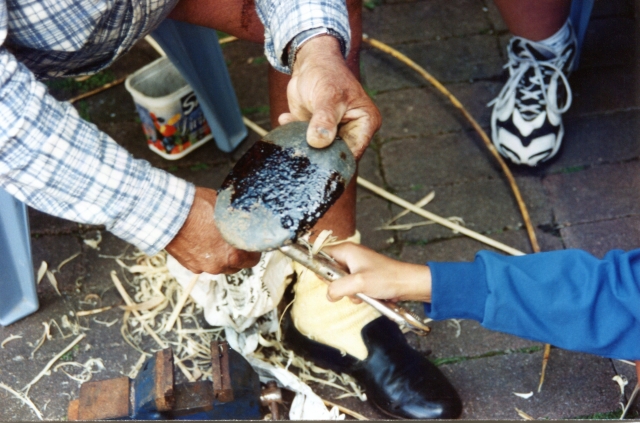
Image 14
The main handle is shaped to accept the axehead.
The glued halves of the base of the main handle are glued together and clamped.
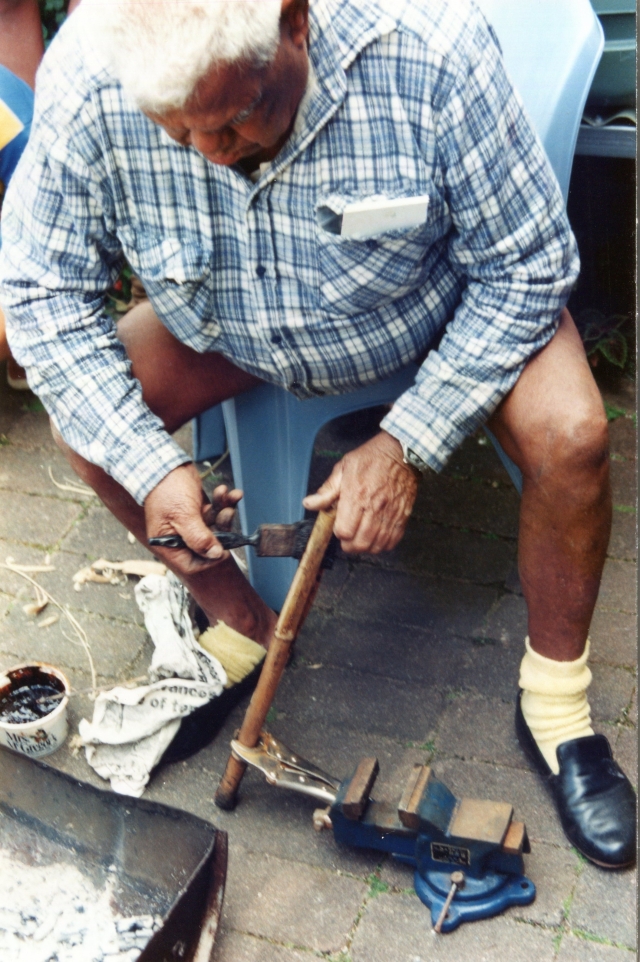
Image 15
Axehead is inserted and clamped.
A two person operation.
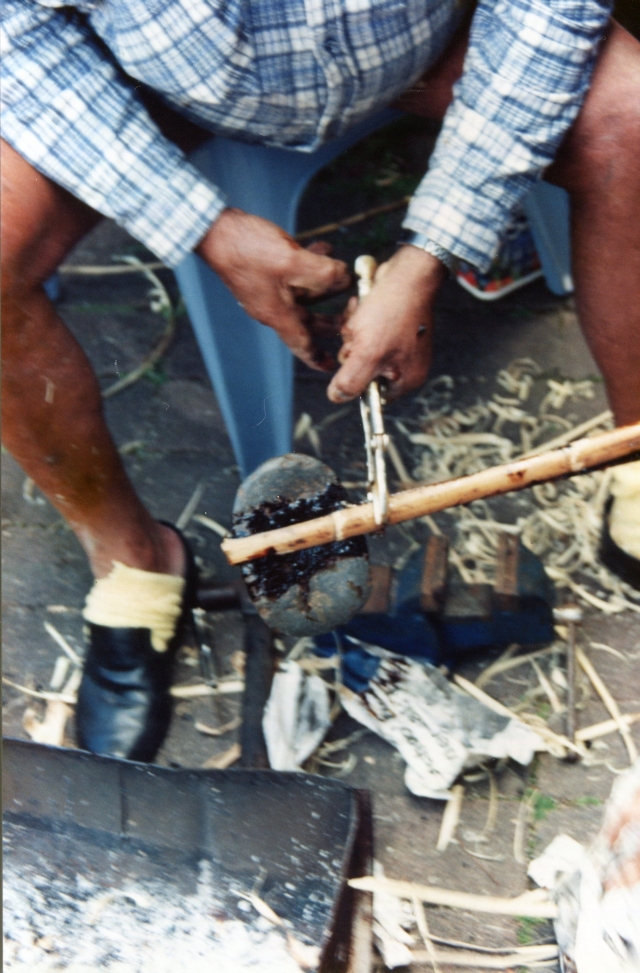
Images 16-17-18-19
Multi-step adjusting and tight fitting of axehead.

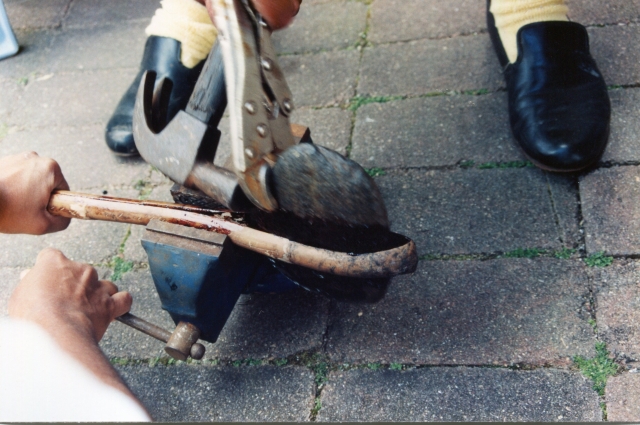
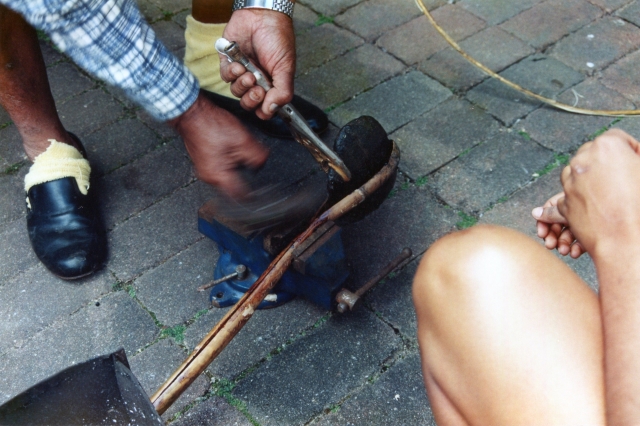

Images 20-21-22-23-24-25
Handle is wrapped and glued inside and out.

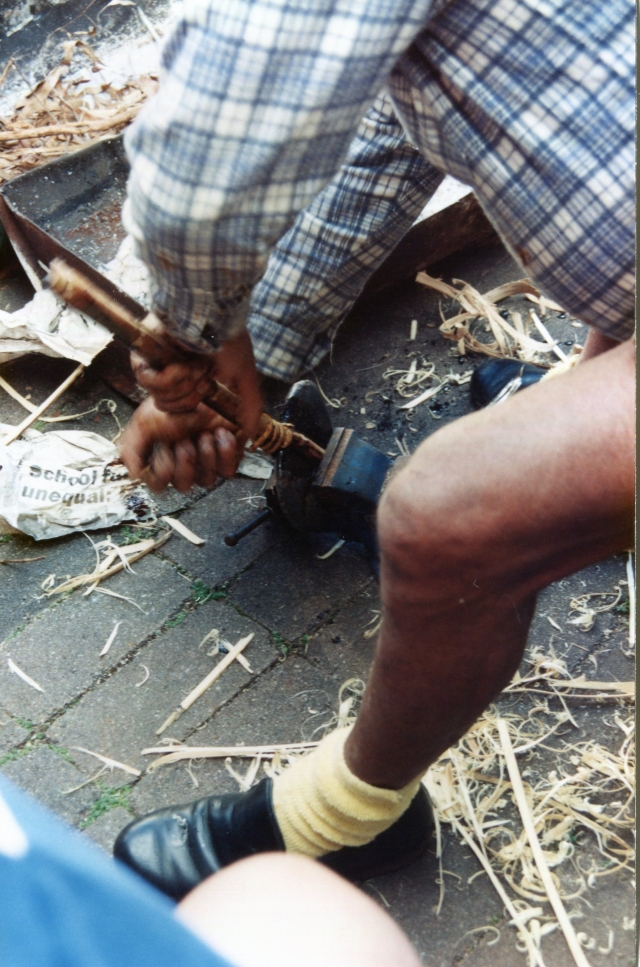
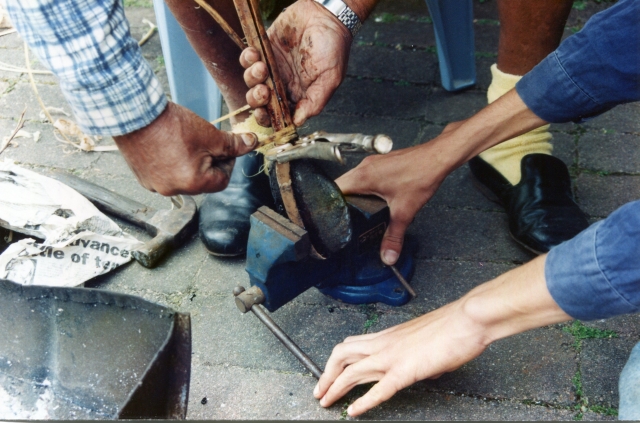
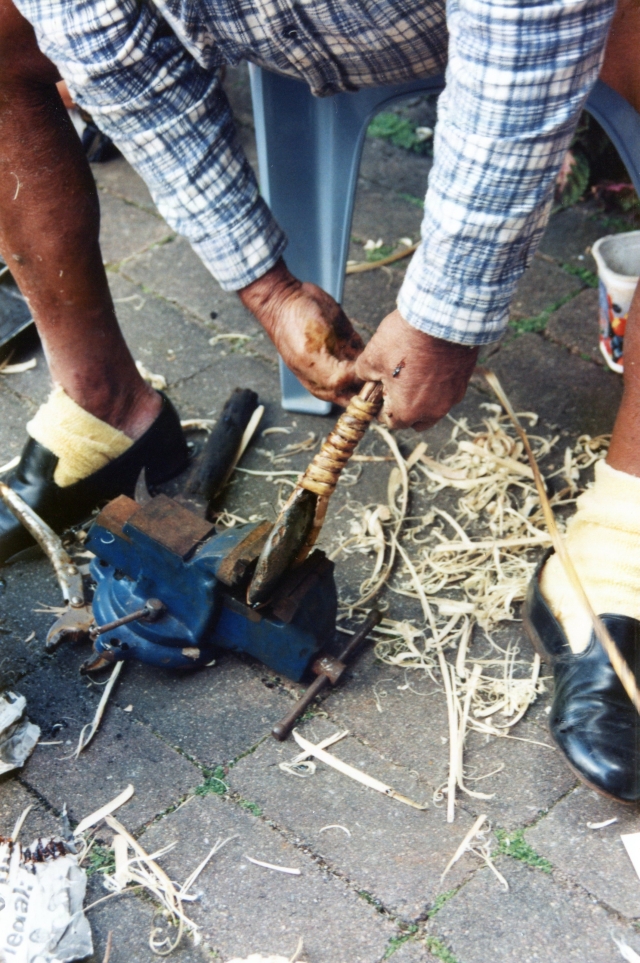
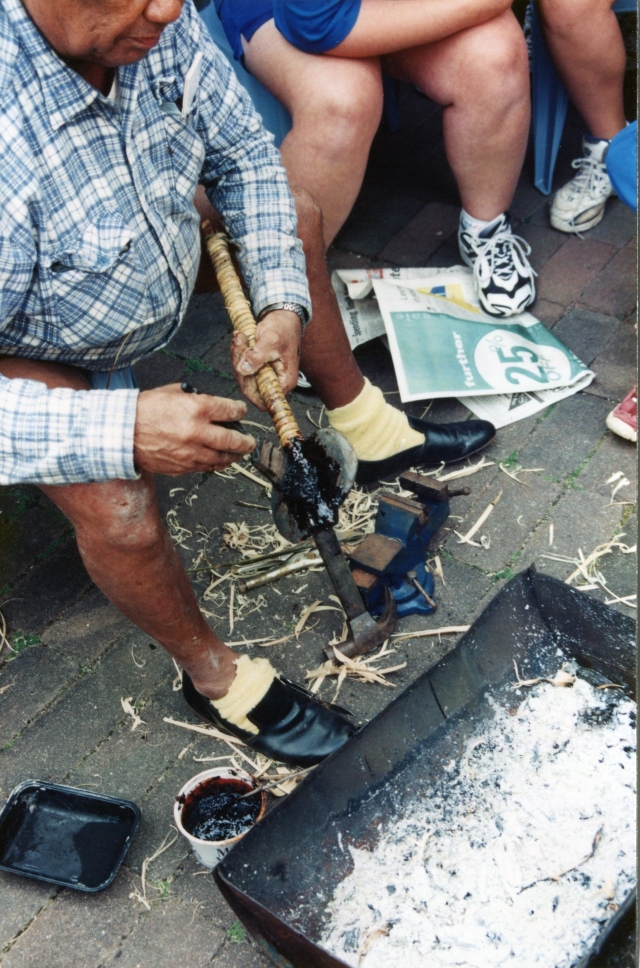

Image 26
Critical to the wrapping are the special knots to hold tie off and hold the wrapping in place.
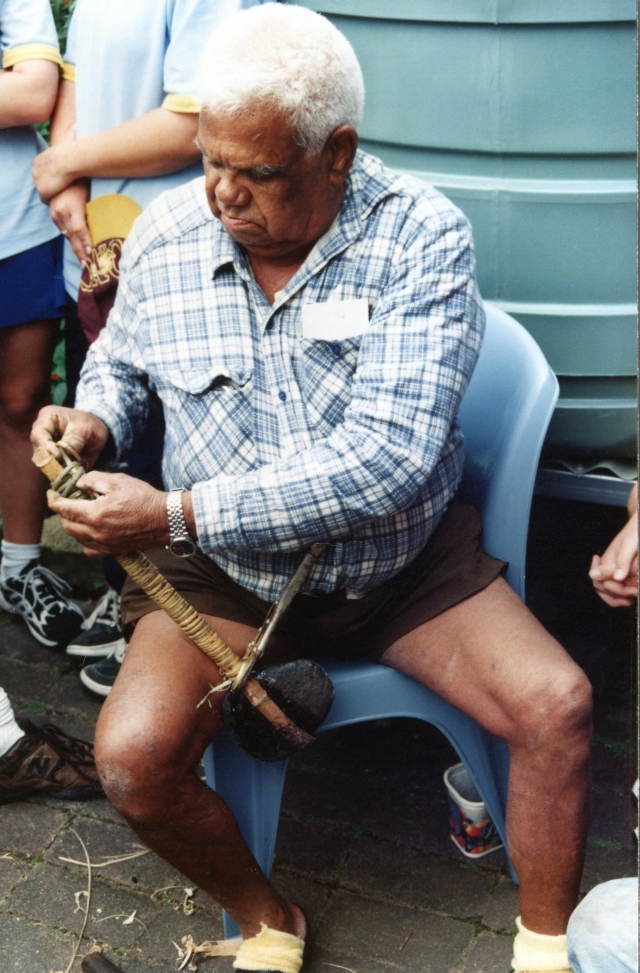
Image 27
Completed axe will take some time to dry and for the green Lawyer Cane to dry and shrink.
This must take place before first use.
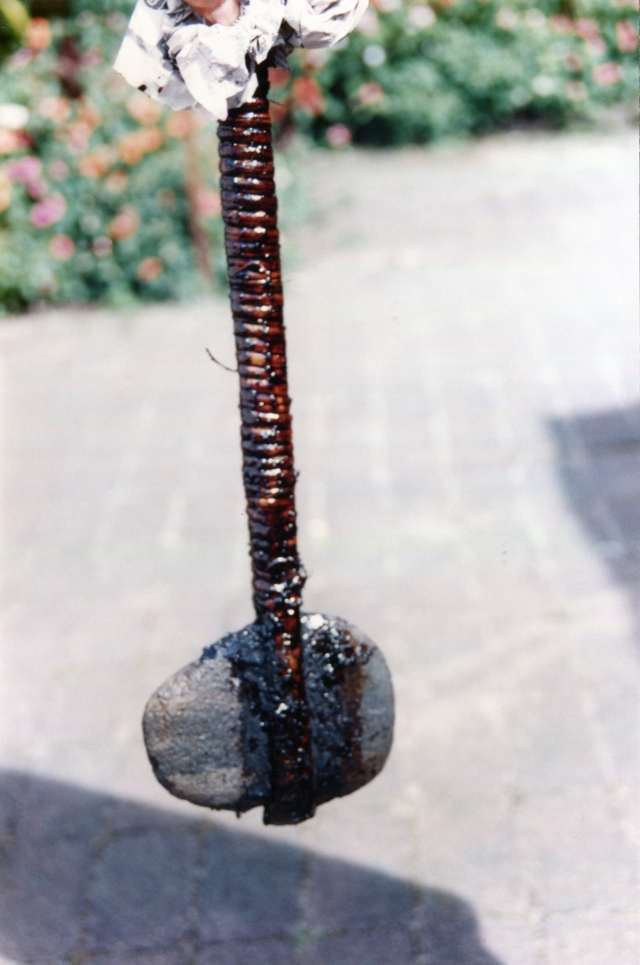
Image 28
Completed Axes - side view with scale
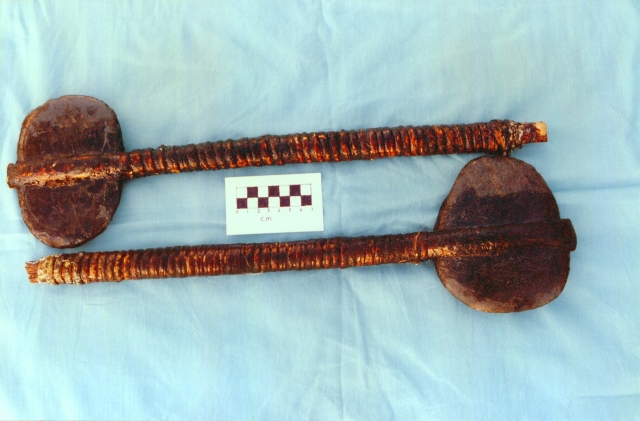
Image 39
Completed axes edge on view
Note how straight cutting edge of axe lines up perfectly with line of axe handle.
Note how glue makes perfectly seamless seal.

Geoarchaeology
or how we used rock type,edge angles and scratch marks to figure out
the uses and origins of each of the stone tools
- Using false colour image processing to
highlight worked areas of stone and scratch mark patterns
- using scratch mark patterns to
determine degree of use, nature and direction of motion
- using edge angles to determine hardness
and nature of material cut
- the metamorphic rocks that comprise axeheads 1,2,3 and 4 have unique properties
Terrain analysis
Working out old trade routes from topographic and drainage mapsHow did axehead number 4 travel the 1000km from the Kalkadoon area near Mt. Isa to Herberton?
We assumed that travel took place in early to mid-winter June-July)for the following reasons:
- still some water flow in rivers,
- rivers around the Gulf would be avoided because of the need to swim, brackish water difficult swampy terrain and large crocodiles
- some shade most leaves yet to drop
- game starting to concentrate aroud drainage basins as outlying terrain begins to dry)
- it would then be possible to follow major drainages with all crossings between watersheds at daily travel distances of less than 30km
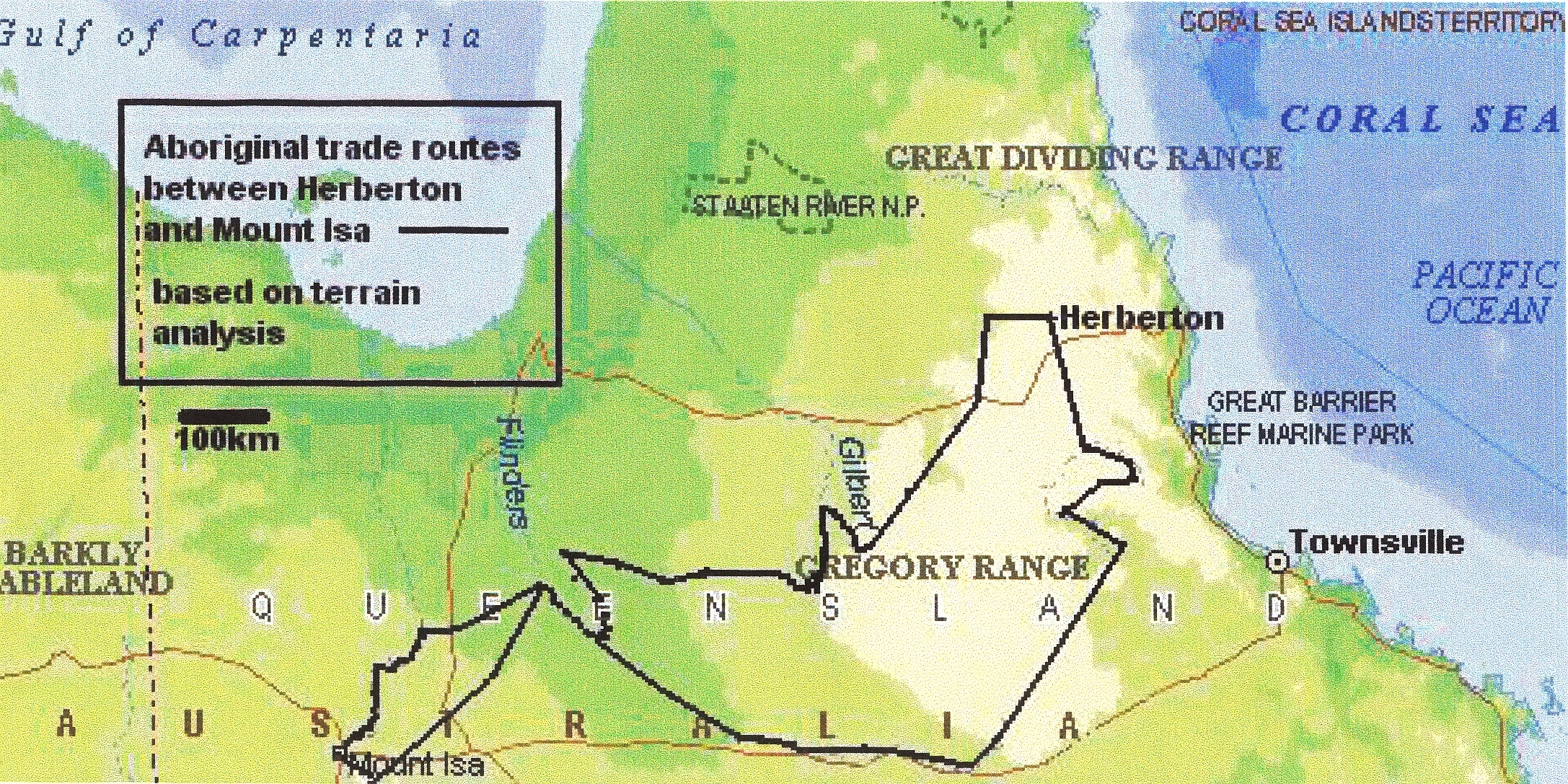
We expected when we tried to meet these criteria that there would be no defined patterns and that numerous routes could be possible. Sixteen volunteers worked individualy using topographic / drainage maps. Much to our surprise only two routes appeared feasible.
- One route through the middle of the Gregory Range following the Gilbert River
- and another southerly route, crossing the Great Dividing Range and following the coastal rivers south and skirting the southern end of the Gregory Range
- it is interesting to note that both routes follow a common path for only a short distance but that the two points where they meet are the sites of present day aboriginal communities
- although the axeheads were collected in June-July they were probably not traded until just before the wet season when people would naturally gather around the few remaining water holes and would therefore be easier to find
- the Kalkadoon axehead from the Mt. Isa area would probably be traded for particular rainforest timbers with unique properties , rainforest coloured feathers in shades and textures not found in the drier interior and seashells which were in turn traded up from the coast
Environmental Reasoning on the Exposure of the Axeheads
The reasons why these axeheads were able to be found in the first place , and why more axeheads are being found now, is mainly concerned with changes in the environment. By looking at environment when the axeheads were made and comparing that to the present environment, we can produce reasoning as to why they were exposed.It is important to realise that when the Aboriginal people mioved to a different place to live, that they usually moved in cycles. That is , they will start at one spot , move to a few others as the cycle of life and food supply progresses, but at some later stage will most likely return to the oroginal spot and so on. Because of this , they leave certain things such as axeheads specificially designed for a particular food supply behind, so that they may be used again when they return to the same spot.
This saves them carrying heavy items from place to place. Acommon place to leave axeheads so that they can be foriun again may be along rivers, near a favourite campsite or a distinguishing tree or feature. Following European occupation of the bush, Aboriginals were deterred from living in the bush, a lot of their axeheads have been left behind. The main reason why these tools are being found now is recent degradation of the land.
In the past:
- the land had a heavy plant cover
- runoff was slow ad over a long period of time
- soils were held inplace by roots
- has been repeatedly logged for building materials
- has been repeatedly burnt either by accident or on purpose
- has had its drainage systems and stream banks altered by tin mining
- has had extensive clearing and numerous roads bulldozed for tin mining
- has had land cleared for farming often right up to the river banks
- the result has been massive soil erosion in drainage basins
- the result has been massive, rapid, short lived runoff and the rapid erosion of stream banks
A consequence of this soil removal and stream bank erosion is the
exposure of axeheads that have collected on the same sites for perhaps
thousands of years.
Triangular marks found on stone tools are often the result of plow or bulldozer impacts.
Each tool tells its story + the wisdom of the elder where our scientific
analysis was wrong and corrected by first hand knowledge...Triangular marks found on stone tools are often the result of plow or bulldozer impacts.

